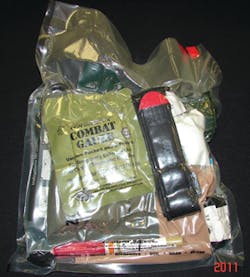Deployable Medical Operator's Kit from CCJA
It seems that recently I'm being exposed more and more to the trauma care needs of contemporary warriors. Now, I understand that the first-aid requirements can run from treating a headache to applying a tourniquet on a partially amputated limb. In general, most adults today know how to treat the simple stuff; the stuff you deal with at home growing up and if you're a parent or guardian for children. What many contemporary warriors aren't trained to do, and it would greatly impact the number of survived injuries if they did, was treat a few common battle wounds that need not be fatal.
A couple years ago I was contracted to write a white paper on a tourniquet system. The system had been developed by a Special Forces doctor who knew, first hand, the positive impact of the timely application of a tourniquet to staunch blood flow for arterial bleeds from the extremities. That application alone is estimated to potentially prevent as much as 65% of battlefield deaths. The challenge is prelocating the tourniquets in a common location and making sure that all contemporary combatants know how to properly apply them.
Just recently I've been schooled on the need to treat two other common battlefield injuries: a blocked airway and tension pneumothorax. A blocked airway used to only be treatable by cutting the larynx and inserting a breathing tube. Another way was to intubate the patient, inserting a breathing tube into the patient's throat. Neither of those treatment options is available to the average soldier or police officer and the large majority of both groups has not been trained to do either one even if the necessary equimpent was available. That said, through the use of an easily inserted nasopharyngeal airway (a tube inserted through the nose) many partially or fully obstructed airways could be opened, saving lives that would be otherwise lost.
Tension pneumothorax is a build up of air inside the chest but outside the lung. The pressure caused by this air build up can cause complete lung collapse as well as cardiac challenges to include cardiac arrest (heart attack). The treatment to relieve the pressure is pretty simple but requires a piece of equipment and the necessary training in its use. The equipment is a large guage needle. The training necessary is to know where to insert it in the chest and how far.
These three injuries/conditions, arterial blood loss, blocked airway and tension pneumothorax, can be treated fairly quickly if the proper equipment and training are provided. Several companies today manufacture (or package) and sell "blow out kits" or "trauma care kits." Most of the ones I've seen contain the necessary equipment to treat the arterial blood loss: pressure bandages and a tourniquet. Usually they also contain a rescue breathing mask and gloves to protect the care giver. Some contain gauze and tape for more simple would care or treatment.
One of the most complete such kit I've seen is packaged and sold by the Commonwealth Criminal Justice Academy (ccjatraining.com). They sell the "Deployable Medical Operator Kit" or DMOK for short. Included in the DMOK's vaccuum sealed clear plastic package are:
- (2) pair NAR Gloves (Black)
- (2) “ETD” Emergency Trauma Dressing NAR
- (1) Primed Gauze
- (2) Chest Seals HALO
- (1) ARS for Needle Decompression (14 gauge x 3.25 in.) NAR
- (1) Combat Application Tourniquet (C-A-T) - Tactical Black
- (1) H & H Tourni-Kwik One-Handed Combat Tourniquet
- (1) Quick Clot Combat Gauze Z-Medica (Haemostatic Agent)
- (1) Nasopharyngeal Airway 28F with Lubricant
- (1) Roll of Tape 2”X100”
- (1) Trauma Sheers
- (2) Safety Pins
- (2) Alcohol Prep Pads
- (2) Cravats
Known to be carried and used by contemporary warriors in the special operations community, the CCJA DMOK contains all the necessary items to treat the most common life-threatening injuries on today's battlefields.
Price for this kit is $175.00 and you can order it by emailing [email protected]. CCJA also has three other kits available, equipped and priced differently. Each kit's contents are tailored to suit the need specified in the name.
- CCJA Basic Life Support “BLS” Kit” $55.00
- CCJA Medical Kit $60.00
- CCJA Trauma Hemorrhage Control “Blood Stopper Kit” $65.00
I recommend you order at least two: one for your daily carry bag, briefcase, etc. and one to keep in your vehicle. Additionally, let's remember that the same injuries can occur during certain recreational activities such as hunting, hiking, etc. It certainly wouldn't hurt to have one of these kits with you if or when you engage in those activities as well.
Stay safe!
Web Links:
About The Author:
Lt. Frank Borelli (ret) is the Editor In Chief for Officer.com, and has 30 years of military and civilian law enforcement experience. An instructor since 1989 and having delivered training across the country, he stays active in police work, training, and writing. Frank has had five non-fiction and two fiction books published along with two research papers of specific interest to the law enforcement and/or military communities. All can be found / purchased on his Author Page on Amazon.com linked above. If you have any comments or questions, you can contact him via email to [email protected].

Lt. Frank Borelli (ret), Editorial Director | Editorial Director
Lt. Frank Borelli is the Editorial Director for the Officer Media Group. Frank brings 20+ years of writing and editing experience in addition to 40 years of law enforcement operations, administration and training experience to the team.
Frank has had numerous books published which are available on Amazon.com, BarnesAndNoble.com, and other major retail outlets.
If you have any comments or questions, you can contact him via email at [email protected].



